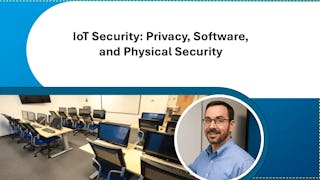In this course, we will study security and trust from the hardware perspective. Upon completing the course, students will understand the vulnerabilities in current digital system design flow and the physical attacks to these systems. They will learn that security starts from hardware design and be familiar with the tools and skills to build secure and trusted hardware.

Enjoy unlimited growth with a year of Coursera Plus for $199 (regularly $399). Save now.

(690 reviews)
Skills you'll gain
Details to know

Add to your LinkedIn profile
7 assignments
See how employees at top companies are mastering in-demand skills

There are 7 modules in this course
To learn hardware security, we first need to learn how hardware is designed. This week's lectures give an overview of the basics on digital logic design, which is a semester-long course for freshmen and sophomores in most schools. By no means we can cover all the materials. What we provide here is the minimal set that you need to understand about digital design for you to move on to learn hardware security.
What's included
7 videos2 readings1 assignment
As a hardware designer or a company, you want to protect your design intellectual property (IP) from being misused (by users, competitors, silicon foundry, etc). We will cover how you can build such protection during the design process which can be used as an evidence to support law enforcement protection. You are expected to understand the basic digital logic design knowledge covered in week 1. We will use several NP-hard problems as examples to illustrate the concepts of IP protection. These problems (graph vertex coloring problem and graph partitioning problem) will be introduced in the lecture and you do not need to know the concept of NP-complete.
What's included
6 videos1 reading1 assignment
This week you will learn the fundamentals about physical attacks: what are physical attacks, who are the attackers, what are their motivations, how can they attack your system (from hardware), what kind of skills/tools/equipment they should need to break your system, etc. You will also see what are the available countermeasures. You will learn how system security level and tamper resistance level are defined and some general guidelines on how to make your system secure by design. In the second part, you will learn a useful mathematical operation called modular exponentiation. It is widely used in modern cryptography but it is very computational expensive. You will see how security vulnerability might be introduced during the implementation of this operation and thus make the mathematically sound cryptographic primitives breakable. This will also be important for you to learn side channel attack next week.
What's included
7 videos1 reading1 assignment
This week, we focus on side channel attacks (SCA). We will study in-depth the following SCAs: cache attacks, power analysis, timing attacks, scan chain attacks. We will also learn the available countermeasures from software, hardware, and algorithm design.
What's included
5 videos1 reading1 assignment
This week we study hardware Trojan and trusted integrated circuit (IC) design. Hardware Trojans are additions or modifications of the circuit with malicious purposes. It has become one of the most dangerous and challenging threats for trusted ID design. We will give hardware Trojan taxonomies based on different criteria, explain how hardware Trojan work, and then talk about some of the existing approaches to detect them. We define trusted IC as circuit that does exactly what it is asked for, no less and no malicious more. We will illustrate this concept through the design space analysis and we will discuss several practical hardware Trojan prevention methods that can facilitate trust IC design.
What's included
5 videos1 reading1 assignment
This is the last week and we will cover some positive things on hardware security. We start with trust platform module (TPM), followed by physical unclonable functin (PUF), and FPGA-based system design. We conclude with a short discussion on the roles that hardware play in security and trust.
What's included
6 videos1 reading1 assignment
What's included
1 assignment
Instructor

Offered by
Explore more from Computer Security and Networks
 Status: Free Trial
Status: Free TrialIllinois Tech
 Status: Free Trial
Status: Free Trial
University of Maryland, College Park
Why people choose Coursera for their career




Learner reviews
690 reviews
- 5 stars
60.86%
- 4 stars
22.17%
- 3 stars
9.27%
- 2 stars
4.49%
- 1 star
3.18%
Showing 3 of 690
Reviewed on Mar 28, 2019
Some the information around PUFs seemed a bit arbitrary,All in all a good introductory course.
Reviewed on Feb 10, 2017
It was a very nice course. Lots of exposure was given to mathematical ways of analyzing threat.
Reviewed on Sep 10, 2017
Nice, instructive course.However, from time to time I felt I would need to have access to the copies of the slides, not currently available.

Open new doors with Coursera Plus
Unlimited access to 10,000+ world-class courses, hands-on projects, and job-ready certificate programs - all included in your subscription
Advance your career with an online degree
Earn a degree from world-class universities - 100% online
Join over 3,400 global companies that choose Coursera for Business
Upskill your employees to excel in the digital economy
Frequently asked questions
To access the course materials, assignments and to earn a Certificate, you will need to purchase the Certificate experience when you enroll in a course. You can try a Free Trial instead, or apply for Financial Aid. The course may offer 'Full Course, No Certificate' instead. This option lets you see all course materials, submit required assessments, and get a final grade. This also means that you will not be able to purchase a Certificate experience.
When you enroll in the course, you get access to all of the courses in the Specialization, and you earn a certificate when you complete the work. Your electronic Certificate will be added to your Accomplishments page - from there, you can print your Certificate or add it to your LinkedIn profile.
Yes. In select learning programs, you can apply for financial aid or a scholarship if you can’t afford the enrollment fee. If fin aid or scholarship is available for your learning program selection, you’ll find a link to apply on the description page.
More questions
Financial aid available,


